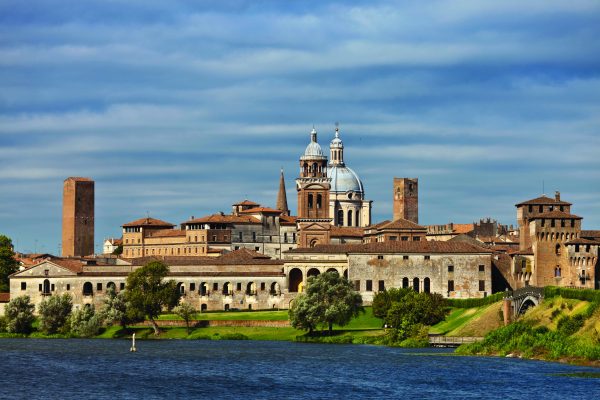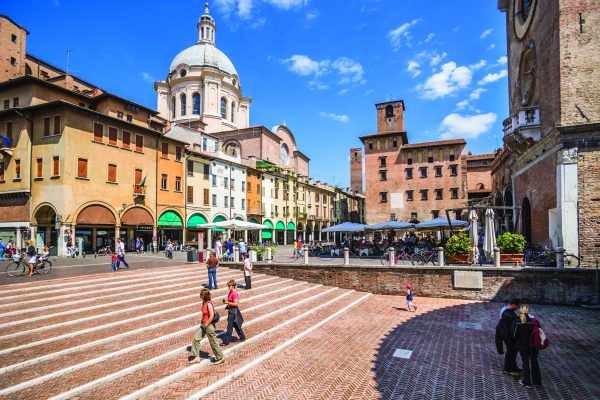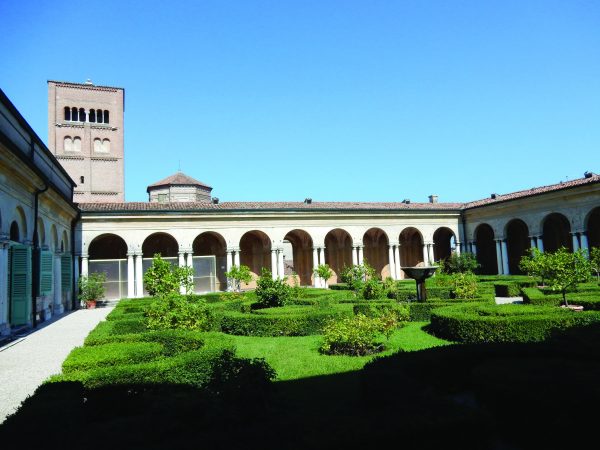This is the city to which Romeo was banished, and it is also home to a palace entirely dedicated to love. Little wonder, then, that one English author considered it to be the world’s most romantic city, writes Jane Keightley
Images by Jane Keightley unless otherwise stated

Aldous Huxley once called Mantua “the most romantic city in the world” with its huge castle and palace rising up from the three lakes that surround it. I was here to discover its tempestuous history and its wonderful art. I was also looking forward to a boat trip out on the lakes to take in the scenery and see the wildlife.
However, the first thing I did after my journey was to find a restaurant and try out the local speciality tortelli di zucca alla mantovana, a pasta dish made with pumpkin and amaretti biscuits. It was really good but very rich! Happy and replete and with my case unpacked, I set off to explore. I love the feeling I get just before discovering a whole new place.
First of all, I decided to go and book my boat trip for the next day. Bordered by man-made lakes on three sides, the city is enclosed within them just as it was hundreds of years ago. Originally there was a fourth lake, but it dried up in the 18th century. Built for defence purposes in the 12th century, the three lakes – Lago Superiore, Lago di Mezzo and Lago Inferiore, (the dried up lake was called Lago Paiolo) – are fed by waters from the Mincio River, a tributary of the Po which comes down from Lake Garda. Having booked my boat trip for the next day, I decided to wander around and get my bearings. Mantua’s history is very much tied up with the Gonzagas, one of Italy’s richest and most powerful families who ruled the city for three centuries, and they have certainly left their mark in the form of the Palazzo Ducale and the Palazzo Te.
Historical center

A little weary after my journey and exploring, I headed off to my hotel. I was staying at the Hotel Broletto, a friendly, family-run hotel in the middle of the historical centre between Piazza delle Erbe and Piazza Sordello, the grand cobbled square where the Palazzo Ducale is situated. The balcony of my room overlooked the main street and before I went out to eat I stood and watched the beginning of the passeggiata – the stroll Italians love to take in the early evening. I headed off to eat, eager to try stracotto d’asino, another of the specialities of the area. It is a rich stew of donkey meat that is cooked for eight hours and I was determined to try it while I was here. It is not usually served nowadays in the restaurants in the centre for fear of upsetting the tourists, but I managed to track some down to try. To be quite honest, I could not tell the difference between donkey and beef and it certainly tasted good.
The next morning I was meeting Lorenzo Bonoldi, who I had been told was one of the best and most knowledgeable guides in Mantua. As soon as we met he presented me with a book that he had written about Isabella d’Este, a Renaissance woman who had married into the Gonzaga family. I was very impressed. Exploring the Palazzo Ducale and the other sights of Mantua with him was a joy. His passion for his subject was plain to see and to have him all to myself was an added bonus. He made the past come alive as we wandered through the many frescoed rooms of the Palazzo Ducale, including the two studioli that belonged to Isabella. I loved seeing the Mantegna frescoes in the Camera degli sposi (the bridal chamber) that I had seen pictured in so many art books. My favourite story he told me was about how visitors trotted up the graduated staircase on their horses to an upstairs receiving room in all their armour and finery. I was also impressed by the roof garden.
As we wandered across the cobbled piazza (which he laughingly explained to me that only Italian girls could walk across in high heels), we went for a coffee before exploring more of the city. We headed off from Piazza Sordello through Piazza Broletto to Piazza delle Erbe, where we admired the 11th-century Rotonda di San Lorenzo. For many years this had been hidden from view, until all the houses around it were demolished. It now stands here in its former glory and you can go inside to see the remains of the 12th- and 13thcentury frescoes.
In Piazza Mantegna we found the Basilica di Sant’Andrea, which safeguards the golden vessels said to hold earth soaked by the blood of Christ. Longinus, the soldier who speared Christ on the cross, is said to have scooped up the earth and buried it in Mantua after leaving Palestine. These containers now rest beneath a marble octagon in front of the altar and are paraded around Mantua in a grand procession on Good Friday. Andrea Mantegna, whose art covers the walls of the Palazzo Ducale, is also buried here.
The final stop on my tour with Lorenzo was the Teatro Bibiena, which is famous for hosting a 14-year-old Wolfgang Amadeus Mozart, who played here in 1770. It is shaped like a bell and has four storeys of stucco balconies arranged around curving walls. Before we parted, Lorenzo advised me not to miss visiting the Palazzo Te.
A trip on the lake

I had decided to leave my visit there till my last day as I was now hot and tired and relishing the thought of a relaxing trip on the lake. I am so pleased that I booked the boat trip! Seeing Mantua from the water was a revelation. It looked completely different and the cooling breeze was bliss. Everywhere you looked there was an opportunity to take beautiful photographs of the wildlife. Herons, swans, ducks and moorhens abounded. As I disembarked I felt a lot more lively and was looking forward to my last evening in Mantua. Before I ate I wandered down to the lake’s edge, where there was a medieval fair with activities such as axe-throwing!
The next morning I headed off to the Palazzo Te, which is on the outskirts of the city, but it wasn’t a long walk as Mantua is a small and compact city. Palazzo Te was conceived as a love nest for Duke Federico Gonzaga and his mistress, Isabella Boschetti. I have seen a lot of frescoes in my travels around Italy but nothing quite like the ones that adorn the walls here. The Sala dei giganti is full of grotesque giants and monsters, and the Cupid and Psyche room, where the Duke held his banquets, depicts bacchanalian scenes beyond description.
As I wandered back to the centre to have lunch I enjoyed looking in the shop windows at all the local foodie delights. One of the best known local specialities is torta sbrisolona. It is like the top of an apple crumble but crisper. According to local tradition it is not cut into slices, but is broken up by punching it in the middle; if it crumbles, it has been well made! Another unusual, crunchy dessert is the sweet torta di tagliatelle, made with thin egg noodles and almonds.
I had heard that Mantua had quite a few literary and musical connections. It was the birthplace of the poet Virgil and also the refuge where Shakespeare sent Romeo into exile from Verona, and it is also the setting for Verdi’s opera Rigoletto. These links are all celebrated in street names and monuments around the city. Indeed, there is a Casa di Rigoletto, which you can visit and have a photo taken with his statue.
My stay in Mantua was nearly over and as I returned to pack in my hotel room, I stepped out onto my balcony to enjoy the view one last time. I gazed at the tower on my right that had a metal cage hanging from it. Lorenzo had told me the story of the Torre della Gabbia, the Tower of the Cage. Duke Guglielmo Gonzaga had the cage erected on the tower. The cage was used to publicly expose criminals as a warning to the public. In 1798, the municipality asked the owner to destroy the cage but it was preserved to show the history of the tower.
So yes, I do agree with Aldous Huxley that Mantua is an evocative, romantic city, but it certainly has its gruesome stories too.
